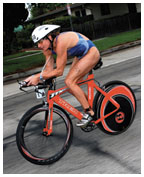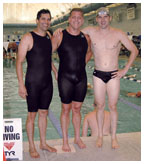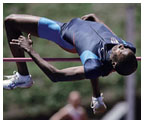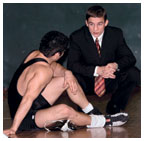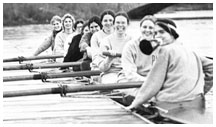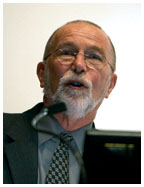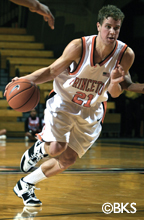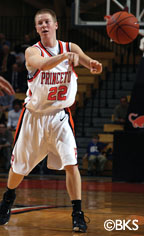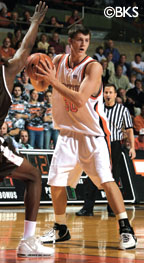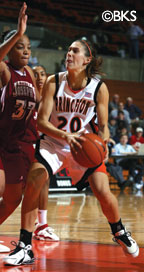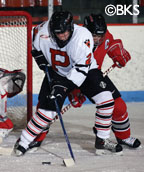
|
January 24, 2007: Sports
Still playing to win
Old Tiger athletes never die; they become masters
Stronger, tougher Tigers
Wrestling coach hopes to instill tenacity
Great from the start
In the early 1970s, Princeton’s women’s teams served notice
to their Ivy peers
Pushing the pace
Women’s basketball searches for consistency and quick points
Sports Scores — Updated weekly
MORE SPORTS ON THE BLOG, click here.
Still
playing to win
Old Tiger athletes never die; they become masters
By Rhoda Jaffin Murphy ’80
Karen Smyers ’83 has been a professional triathlete for 26 years. (Rich Cruse)
Master swimmers, from left, Mark Pugliese ’74, Bill Specht ’80, and Mike Ross ’90. (courtesy Mike Ross ’90)
Bruce McBarnette ’80 has set world records in masters track and field. (courtesy Bruce McBarnette ’80) |
For years, Bill Specht ’80 has followed the same routine: Wake up at 4:30 a.m., swim for an hour and a half in his backyard lap pool or at the St. Petersburg (Fla.) Aquatic Club, drive his young kids to school, and head to work. Specht, who was an All-America swimmer at Princeton, is simply continuing what he has done since he was 6 years old (“It is who I am,” he says), and his tireless training has paid off. He has held as many as 30 masters swimming world records over the years.
In the universe of former Princeton athletes, Specht is not an anomaly. There are many others who see no point in hanging up their goggles, cleats, or rackets, even when college is a distant memory. In fact, for most, competitive sports are a pleasurable part of growing older. At ages when many people are bemoaning expanding waistlines, these ex-Tiger athletes are traveling the globe to compete. They run the gamut from platform tennis (Aila Winkler Main ’92, ranked first in the country) to ball hockey (Matt Zilinskas ’93, a competitor in the world championships).
For alumni athletes, sport is such an integral part of life that they cannot imagine living without it. Jim Adams ’61, who fences internationally, says that competition allows him to see the world and stay young. “A few years ago,” he says, “around 20 of us from our fencing club were at a national event and went out to dinner together. Everyone at the table was either in high school or in their 20s, except me. I suddenly realized that I wasn’t out of place. ‘I’m a fencer,’ I thought. ‘I belong.’”
The idea of retiring from competition is also beyond their ken. “Unless I get some injury that won’t heal, I’ll do it forever,” says long-distance runner and Canadian masters champion Jerry Kooymans ’78. Fellow runner Tom Hartshorne ’76 (famous at Princeton for racing barefoot) holds masters track records in the 800 meters and concurs with Kooymans: “Do I see myself still racing when I’m in my 70s or 80s? Of course.” Swimmer Mike Ross ’90 has found such personal fulfillment in masters swimming that he is already looking toward the long term. “I want to be swimming masters when my son is swimming masters,” he says.
Among Princeton’s alumni athletes, some were Tiger superstars, but others have gotten even better post-Princeton. Take Bruce McBarnette ’80, who was a novice high jumper as a freshman. By his senior year, he was one of the top high jumpers in the Ivy League. Now, McBarnette is one of the best in the world and a legend in masters track, holding 15 national records and three world records.
Karen Smyers ’83 was, by her own admission, a mediocre swimmer at Princeton. “I only qualified for the Easterns once,” she remembers, “and that was for the relay because one of the stars got injured.” But she has found her métier as a professional triathlete. In 1999, she won the Hawaii Ironman for women. She has been competing professionally for an astonishing 26 years, virtually always finishing, as she says, “in the money.”
While most adults cringe at the sight of another candle on the cake, masters athletes (they are alternately known as “veterans” or “seniors,” depending on the sport) love getting older, particularly when it means moving up an age bracket. “That’s the greatest thing about this,” says Debbie Ross Cipriano ’79, a highly ranked masters triathlete. “You look forward to birthdays.”
How do masters athletes keep from getting injured? The secret, alumni say, is avoiding over-training. Most cross-train, and all listen carefully to their bodies, stopping when they feel pain. Smyers credits her less-than-fanatical approach to training for keeping her in the sport after battling cancer and being run off the road on her bike by an 18-wheeler. “I’m a low-mileage person,” she says. “That’s probably why I’ve stuck it out so long. I just do enough training to get me to the race.”
Another joy of masters competition is that you can start at any age
and in virtually any sport. Andy Gustafson ’63 discovered this for
himself, as he told his classmates in the Class Notes of a recent PAW.
When he turned 65, Gustafson decided to take up bicycle racing and soon
found himself the U.S. Cycling Federation Masters over-65 climbing champion
for California and Nevada. “After six and a half decades of weeniehood,”
Gustafson wrote, “I have at last achieved athletic glory. My secret:
You don’t have to get faster, you just have to wait until all the
real athletes get fat or die.” ![]()
Rhoda Jaffin Murphy ’80 is a freelance writer based in Short Hills, N.J.

Stronger,
tougher Tigers
Wrestling coach hopes to instill tenacity
Wrestling head coach Chris Ayres talks with 161-pound competitor Alex Enriquez ’09 during the Tigers’ homecoming loss to Maryland Dec. 10. (Beverly Schaefer) |
Entering his freshman year at Lehigh University in the mid-1990s, Chris Ayres told friends that he planned to wrestle in college. His friends did their best to keep a straight face. Ayres had not even earned a medal in the New Jersey state tournament in high school. How did he expect to compete for a top Division I college team? “Maybe I was naïve,” said Ayres, Princeton’s new head wrestling coach, in a recent interview. “But I wanted to be the best that I could be, and in order to be the best, I had to wrestle the best guys in the country.”
In his first two seasons, Ayres beat out high school state champions from Pennsylvania and New York to earn a spot in Lehigh’s lineup, and by his junior year, he was an Eastern Intercollegiate Wrestling Association champion. As a senior, he earned All-America honors at the NCAA meet. Ayres’ experiences taught him several lessons that he hopes to instill in his Princeton squad, including one that seems particularly apt this year: “Don’t be limited by what you’ve done in the past.”
No wrestler on the Princeton team has been part of a dual-meet win in Ivy League competition (the last one came in 2003), and the Tigers lost their first eight meets to start this season. But Ayres said he sees signs of progress, both in meets and in practice. His top priority is building a sense of toughness and tenacity that will make opponents work for every point. “You could teach all the moves in the world, all the best technique,” Ayres said. “[But] if they don’t have that fight out there, it’s for nothing. I’ll take a scrapper any day over the perfect, athletic technician.”
The 32-year-old Ayres is looking to the future as well, aggressively recruiting with the help of assistant coach Troy Letters, a recent Lehigh graduate who won the 2004 NCAA title in the 165-pound division. Word of mouth goes a long way in the tight-knit wrestling community, Ayres said, and talented student-athletes are interested in Ivy programs, as Cornell, Penn, and Harvard have shown. Seven Ivy wrestlers were All-Americans last year, and Princeton’s Greg Parker ’03 was an All-American twice, in 2002 and 2003.
On the mat this season, Princeton has faced some of its strongest opponents
in recent memory, including 12th-ranked Hofstra, and the Tigers will play
their entire five-meet Ivy stretch in a 15-day span in February, followed
by the EIWA Championships on the first weekend in March. “As we
improve through the year, I think we’ll close the gap on those tough
teams,” Ayres said. “We’ll have little victories. We
might not get the huge dual-meet win against a great, ranked team, but
we can win some matches. ... I think by March this team is going to be
the best it can possibly be.” ![]()
By B.T.

Great
from the start
In the early 1970s, Princeton’s women’s teams served
notice to their Ivy peers
By Stephen Eschenbach
Women’s crew, shown here in 1974, emerged as an Eastern power in 1972, its first varsity season. (1974 Nassau Herald) |
For much of the Ivy League’s first 50 years, Princeton athletics teams have been among the league’s best, winning more than 300 Ivy championships. Strong women’s teams have led the way for the Tigers in recent years, including 2005–06, when Princeton won titles in seven of
the 16 Ivy women’s sports. Stephen Eschenbach, a co-editor for the Ivy League’s 50th anniversary Web site, takes a closer look at women’s athletics on campus at the dawn of coeducation.
In Ivy League history, the rise of women’s athletics at Princeton was a remarkable event. The Tigers won five women’s individual and team national championships in their first five years, along with numerous other titles, leaving their peers to wonder: How did they get so good so fast?
Recruiting and admissions contributed to some strong teams, including women’s tennis, which started in 1971 and didn’t lose a match for five years, winning three Eastern Intercollegiate Championships. In swimming, Princeton’s first star was Cathy Corcione ’74, who swam in the 1968 Olympics in high school. Corcione set seven national swimming records at Princeton as the team won the Eastern Collegiate Championship in 1974 and finished third in the 1973 AIAW Championships (the national championship before the NCAA began contesting championships for women). Wendy Zaharko ’74, who played squash in high school, won national championships in 1972, 1974, and 1975. The women’s squash team reigned as national champions for two seasons during Zaharko’s time on campus.
Attracting top athletes was not the sole reason for Princeton’s success, though. Carol Brown ’75, who was on the University’s first women’s swimming, ice hockey, and rowing teams, never had rowed before coming to Princeton. “At registration Amy Richlin [’73] handed out flyers saying ‘Come try crew — if you liked to do things the easy way, you wouldn’t have come to Princeton,’” Brown recalls. She was hooked. Women’s crew encountered resistance from the men’s coach, Brown says, so the women’s team practiced at 7 a.m., staying out of sight. When the women began to compete, they made a smashing debut: In 1972, women’s crew’s first year as a varsity sport, Princeton won the Eastern Sprints.
As women began to show their strengths on the field of play, some men on campus lent their support to the women’s teams. Brown remembers Pete Raymond ’68 helping the women rowers before he left to train for the 1972 Olympics, and a graduate student, Al Piranian *74, served as a volunteer rowing coach as well. Players from the men’s team coached the women’s ice hockey team in its first season. In field hockey, alumni who graduated long before coeducation provided financial support, according to Suzanne Perles ’75, an original team member.
The University supported its teams relatively well. At Yale, the field hockey team’s first official practice field was a parking lot used for tailgating before football games. “We’d spend Mondays picking up cans and charcoal,” says Lawrie Mifflin, one of the Yale team’s founding members. By comparison, Princeton’s team had access to a field in its first year and University-supplied uniforms, of a sort. “Carpenters made real field hockey goals,” Perles says, “and we used cheerleading skirts as uniforms.” The Tigers scheduled the most challenging opponents they could find and won consecutive H-Y-P titles in their first two years of competition. Since the Ivy League began awarding field hockey championships in 1979, Princeton has won or shared the Ivy title 15 times.
The women’s sports offerings grew to include 14 varsity teams
in the first six years after the start of coeducation at Princeton. Many
of the early women athletes went on to great success after graduation,
including Brown, who participated in three Olympics, medaling in 1976,
and Perles, who was a member of the first Rhodes Scholar class to include
women. Looking back on the rapid rise of the women’s teams, Brown
says simply, “We weren’t going to wait.” ![]()

As part of its 50th anniversary celebration, the Ivy League has established a Web site, www.ivy50.com, on which one former student athlete is profiled every weekday throughout the anniversary year. Princetonians profiled on the
Ivy@50 site include Yasser El Halaby ’06, Jesse Hubbard ’98,
Maya Lawrence ’02, Mollie Marcoux ’91, Craig Masback ’77,
John O’Brien ’65, Suzanne Perles ’75, Michael Spence
’66, and Will Venable ’05. ![]()

(Frank Wojciechowski) |
Thirty-five years after the U.S. table tennis team’s journey to
China introduced “ping-pong diplomacy” into the lexicon, Princeton's
table tennis club hosted players from Peking University in December as
part of the team’s two-week American tour to promote the 2008 Olympics
in Beijing. Pan Lin ’08, left, faced Peking’s Shi Shengnan
in one of seven exhibition matches at Dillon Gymnasium. Peking coach Liang
Geliang, a former world champion and a participant in the China-U.S. matches
of the 1970s, also played in the event, facing Adam Hugh ’09, Princeton's
top player and the runner-up in singles at the national collegiate championships
in April. Lin and Hugh won their matches, but the Chinese team won the
other five. ![]()

(Hyunseok Shim ’08) |
“I want to give students tools to think about their own involvement in sports. … Are you bored by jogging until it becomes a race? Do you only do your best after you work yourself into a rage against your opponent? What does that tell you about yourself? The point of this effort at self-knowledge is to turn us into better people, to improve us as human beings.”
Drew Hyland ’61, professor of philosophy at Trinity College, in
a Nov. 30 lecture sponsored by the Princeton Varsity Club. Hyland, who
played varsity basketball at Princeton, said his experience with athletics
was “at the very core” of his education. ![]()

Meet
the new kids
Freshmen deliver in men’s basketball’s fast start
Marcus Schroeder ’10
Lincoln Gunn ’10
Zach Finley
’10 |
Led by a starting five that has included two, and sometimes three, freshmen, Princeton men’s basketball opened with eight wins in its first 12 games. The Tigers, who finished second in the Ivy League last year despite a dismal start, charged out of the gate this season, beating two teams — Manhattan and Northwestern State — that played in the postseason last March.
The Tigers have leaned heavily on their defense, which ranked first in the nation in points allowed through Jan. 1, and forward Kyle Koncz ’08 has emerged as Princeton’s top offensive weapon, averaging 11.5 points per game. The successes of the season’s first two months also included notable contributions from the team’s top three freshmen:
Marcus Schroeder ’10 Schroeder has run the show for the Tigers’ offense since the season’s first game. He also averages two steals per game on defense, but head coach Joe Scott ’87 said that many of Schroeder’s contributions are not found on the stat sheet. The point guard was clutch in his Jadwin Gym debut Dec. 6, draining a free throw with no time remaining to beat Lehigh, 44–43.
Lincoln Gunn ’10 Gunn, who was Schroeder’s teammate at De La Salle High School in California, started each of the Tigers’ first 12 games, averaging 6.8 points. He scored 15 points, all on three-pointers, and dished out four assists at South Carolina Dec. 20, leading a Princeton comeback that fell short in a 54–48 loss to the Gamecocks.
Zach Finley ’10 Finley, a 6-foot-9-inch center
who was South Dakota’s “Mr. Basketball” as a high school
senior, proved more than competent in three starts when captain Justin
Conway ’07 was injured. Finley’s best game came in one of
the Tigers’ most impressive wins: He scored eight points and grabbed
eight rebounds in a Dec. 2 victory over Northwestern State. ![]()
By B.T.

Pushing
the pace
Women’s basketball searches for consistency and quick
points
Meg Cowher ’08 leads Princeton in scoring and rebounding. (Beverly Schaefer) |
After sharing the Ivy League title with Dartmouth and Brown last year, Princeton women’s basketball entered this season as the Ivy favorite in the preseason media poll. Living up to that ranking, head coach Richard Barron said, will hinge on how well the Tigers adjust to a new, up-tempo offensive scheme designed to take advantage of the team’s athletic lineup.
The early season brought mixed results: Princeton beat four opponents by 17 points or more but started the year 6–8. Forward Meg Cowher ’08 has thrived in the new offense, averaging 16.8 points and 7.4 rebounds per game. As a team, however, the Tigers averaged more than 20 turnovers per contest in the pre-Ivy season, a defeating statistic for an offense designed to give Princeton more shots than its opponents.
Before implementing the offense, Barron learned from the experts, traveling to Italy to sit in on a week of training camp with the NBA’s Phoenix Suns. Barron, a friend of Phoenix assistant coach Marc Iavaroni, said that the Princeton women have some of the same elements that have made the Suns successful: a strong point guard, versatile forwards, and extraordinary depth. The Tigers hope to use those assets to generate points before the defense has time to set up.
Barron has seen some promising signs in the play of Casey Lockwood ’08 (10.6 points per game) and Jessica Berry ’09 (a team-best 40 percent shooter on three-pointers). “There’ve been moments in every game where we showed we can do it,” Barron said after one of his team’s December wins, “but ‘getting it’ is being able to do it consistently.”
Last year, Princeton knew exactly where to look for offense: Center Becky Brown ’06 worked for layups under the basket, Katy O’Brien ’06 drained shots from behind the three-point arc, and Cowher scored from all spots between. The three players accounted for nearly two-thirds of the team’s offense. But with Brown and O’Brien lost to graduation, more Tigers are sharing the load.
The Tigers should know where they stand in the Ivy League by mid-February,
after a stretch of games against three traditional powers. They face Brown
at home Feb. 3, travel to Harvard Feb. 9, and play at Dartmouth Feb. 10.
![]()
By B.T.

Anne Greenwood ’09 (Beverly Schaefer) |
Anne Greenwood ’09 tries to find an opening in front of the net in WOMEN’S HOCKEY’s Dec. 30 game against Ohio State. Princeton lost 3–2 but rebounded to beat the Buckeyes 2–1 Dec. 31.
MEN’S HOCKEY compiled a 4–1–1 record in a three-week stretch from Nov. 24 to Dec. 9, including a 4–2 win over Harvard in Cambridge Nov. 25 and a 4–3 overtime victory against Union at home Dec. 8.
WOMEN'S SQUASH opened its season 3–0, and on Nov. 26 freshman Neha Kumar won the Constable Invitational, an individual tournament at Jadwin Gym that draws many of the nation’s top college players. MEN’S SQUASH opened 4–0 in intercollegiate play and placed third in the National Five-Man Team Championships Dec. 8–10.
MEN’S CROSS COUNTRY runner David Nightingale ’08 finished 39th at the NCAA Championships Nov. 20, earning All-America honors. WOMEN’S CROSS COUNTRY placed two runners in the top 100 (Jolee Vanleuven ’09 and Mia Swenson ’07) and finished 23rd in the women’s team standings.
FOOTBALL co-captain and quarterback Jeff Terrell ’07 won the Asa S. Bushnell [’21] Cup as the Ivy League’s top football player, becoming the first Tiger to win the award since Dave Patterson ’96, a linebacker for Princeton’s 1995 Ivy championship team.
Former MEN’S SOCCER player and coach Bob Bradley
’80 was named interim head coach of the U.S. men’s national
team Dec. 8. Bradley has been a head coach in Major League Soccer for
nine years. ![]()

